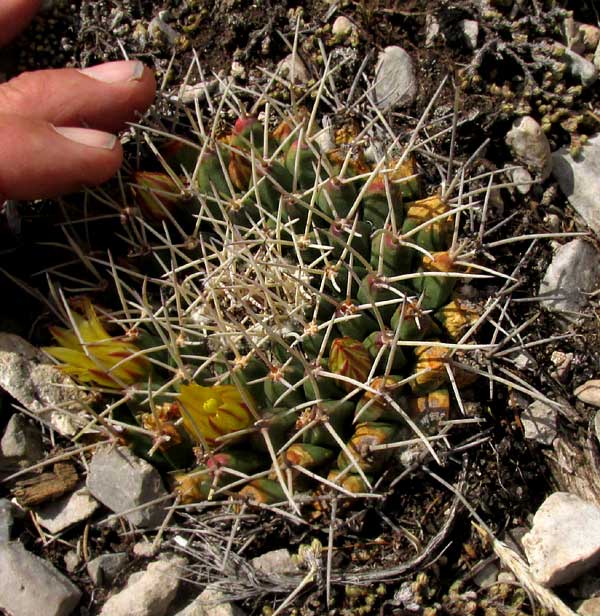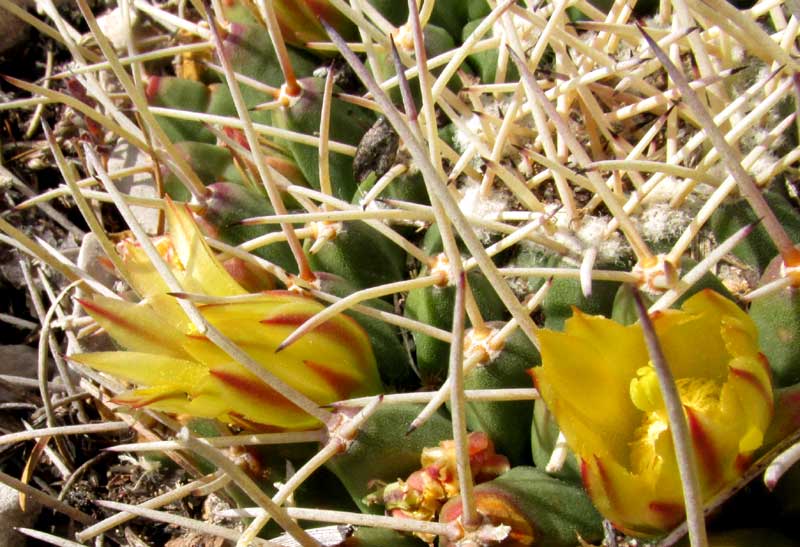Excerpts from Jim Conrad's
Naturalist Newsletter
from the May 17, 2018 Newsletter with notes from a camping trip in the mountains east of Saltillo, Coahuila state, northeastern MÉXICO
HORSE-CRIPPLER CACTUS
During my recent camping trip in the highlands east of Saltillo, Coahuila, on April 5th I started out hiking on a valley floor, and climbed a small mountain that was grassy and scrubby at its base, but forested on top. Toward the top, at ±7000 feet in elevation (2100m), in openings on thin soil atop limestone rock and amid sparse forest of widely spaced pine and junipers, I found the little cactus shown below:

I was especially happy to see this, for during the previous week when I'd been camping in Amistad National Recreation Area in southwestern Texas along the Mexican border, I'd been looking for a Horse-Crippler Cactus, and this was one of them. Back in the 1980s when I camped regularly in Amistad, I'd often seen Horse-Cripplers, but during this visit I couldn't find a single one. Horse-Cripplers get their name because, instead of producing impressive above-ground bodies, they display only the tops of their flattish heads, and their heads are ±level with the surrounding soil. Any critter not watching where the feet go can easily step on one of these, and you can see that the head is heavily armored with hard, sharp spines.
On this mountaintop, Horse-Cripplers were fairly common. However, the species I remembered from Texas, Homalocephala texensis, had vertically ribbed bodies and bore red flowers, while the bodies of these in Coahuila looked like they consisted of many closely packed little green-chili-peppers, and produced yellow flowers. Below, you can see its flowers closer up:

Spine disposition is an important feature in cactus identification, so a typical cluster of four, purple-tipped, whitish spines is shown below:

With such big differences in body structure, these horse-cripplers in Coahuila were obviously a very different species from the one I'd known in Texas. Having two such unrelated species behaving so similarly suggests that presenting oneself as a low-lying, spiny, ±ground-level head can be a good adaptation, one worthy of unrelated species independently evolving the habit -- of undergoing "convergent evolution." In fact, just in Coahuila state five species in four different genera display such a habit, and are known by the Spanish name of Manca Caballo, meaning "horse crippler."
I know this because the excellent, well illustrated, Spanish-language Guía de Cactáceas del Estado de Coahuila by Alfredo Flores {was} freely available on the Internet.
In that publication our Coahuila horse-cripper reveals itself to be THELOCACTUS RINCONENSIS, endemic just to the Mexican states of Coahuila and Nuevo Leon. The literature reports it as occurring up to 2000 meters in elevation -- Flores's Guía says 1500 -- but the ones I found were at 2100m. At some places within its limited distribution its described as "very abundant," but it's losing ground fast to farming, ranching and urban development. Flores describes its growth rate as very slow.
The species is described as variable in appearance, and little-studied, so I'm glad to offer documentation that at least on one mountaintop east of Saltillo, Coahuila, Horse-Cripplers look like the one in our pictures.